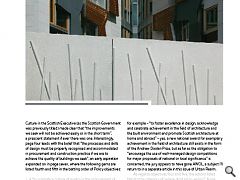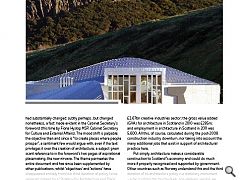Architecture Policy: Policy Wonky
24 Apr 2017
With the Festival of Architecture passing with a whimper not a bang Peter Wilson preps some fireworks by shining a light on architecture policy, illustrating a disconnect between rhetoric and delivery which ensures it’s not fit for purpose. Images from the Scottish Parliamentary Corporate body.
It may surprise many architects – particularly younger ones who may know nothing of this at all – but one of the first acts of the Scottish Parliament way back in 2001 was to introduce a Policy on Architecture for Scotland. The slim, 12-page document was the final output from a two-year process that began with the publication of a framework document, ‘The Development of a Policy on Architecture for Scotland’ and which was followed by a series of consultations around the country involving architects and public. This process resulted in a 200-page summary of the ideas and initiatives proposed. I myself wrote extensively on the subject at the time and organised a major conference with inputs from Finland, the Netherlands and Norway. These countries all had pre-existing architecture policies and many of the objectives within the Scottish version ultimately derived from their experience, albeit without the accompanying finance or statutory functions to enable much, if any, of it to actually happen. It was, to all intents and purposes, a placebo designed to pacify an architectural profession desperate for change, but without the accompanying clear leadership necessary to deliver the follow-on lobbying that could ensure tangible political results. Two decades on from those first stirrings and a further two versions of architecture policy later, is the profession in Scotland in any stronger position as a result than it was then?To be fair, the foreword in the first document by Alan Wilson MSP, then Deputy Minister for Sport, the Arts and Culture in the Scottish Executive (as the Scottish Government was previously titled) made clear that “the improvements we seek will not be achieved easily or in the short term”, a prescient statement if ever there was one. Interestingly, page four leads with the belief that “the processes and skills of design must be properly recognised and accommodated in procurement and construction practice if we are to achieve the quality of buildings we seek”, an early aspiration expanded on in page seven, where the following gems are listed fourth and fifth in the batting order of Policy objectives:
4 “to promote a culture of quality in the procurement of publicly-funded buildings that embraces good design as a means of achieving value for money and sustainable development”
5 “to ensure that the planning and building standards system and their associated processes both promote and facilitate design quality in development.”
For reasons of brevity I haven’t listed the three preceding objectives, but suffice to say that the following pages of ‘actions’ on each of these is a litany of non- or only partial delivery, with most of the latter having now almost completely ceased to exist. In response to objective two, for example – “to foster excellence in design, acknowledge and celebrate achievement in the field of architecture and the built environment and promote Scottish architecture at home and abroad” – yes, a new national award for exemplary achievement in the field of architecture still exists in the form of the Andrew Doolan Prize, but as far as the obligation to “encourage the use of well-managed design competitions for major proposals of national or local significance” is concerned, the jury appears to have gone AWOL, a subject I’ll return to in a separate article in this issue of Urban Realm.
As regards objectives four and five, the actions listed fall into the category of ‘where did it all go wrong?’ Aside from giving advance notice (“review the status, organisation and remit appropriate for a national design body to provide independent advice on development proposals”) that the Royal Fine Art Commission for Scotland (RFACS) was to be replaced by Architecture + Design Scotland, there is not much here that can be described in any other terms than motherhood and apple pie: actions may have been listed with all good intent but, without any indication of either delivery mechanisms or timescales, it was left very much in the lap of the gods as to how many would be realised within the initial three-year policy period.
So to 2005, when ‘A Policy for Architecture in Scotland – Progress Report’ was published. By this time the foreword author had changed – Patricia Ferguson was now the retitled ‘Minister for Tourism Culture and Sport’ and – de facto – Scotland’s Minister for Architecture, a title that doesn’t seem to actually exist but which had seven incumbents in the first years of the Parliament, a measure perhaps of how seriously the subject was taken at political level. By this stage, she felt it safe to announce that A+DS would have twice the resources previously allocated to RFACS. Accompanying this was the promise that, once A+DS had been properly bedded-in, a first formal review of policy would take place in 2006. As a passing comment, One of the results of this “bedding-in” has been the replacement of the eponymous www.scottisharchitecture.com website, launched in 2002, by that of A+DS. Whether the latter is the embodiment of the policy commitment to “develop an online virtual architecture centre… and a central hub for all available information in the field of Scottish architecture” is open to question, given that many architects see little relevance to themselves in the organisation’s agenda and activities but – hey – it still exists, which is more than can be said for the Lighthouse, much-vaunted in its early days as ‘Scotland’s Centre for Architecture and Design’ and a key policy objective from the very start. The venue still stutters along in the hands of its owner, the City of Glasgow Council, but is a pale shadow of its former self. SUST too has gone, one of the bright spots in A+DS’ work, the presence of said organisation in the building now reduced to a rump of staff.
There were some good things produced during this period, however: a series of documents on school design and Planning Advice Notes on designing places and housing quality, for example. Whether these more statutory outputs would have happened without the framework of an architecture policy is a moot point, but at least they were documents architects could find value in. In retrospect, though, the progress report reads very much as an assembly of bits in search of a clear sense of purpose, a loss of direction (and confidence) made manifest in 2006 with the publication of ‘A Policy on Architecture for Scotland – Public Consultation” Review of Policy’. This small document contained 34 questions across 12 topic areas which, stripped of their accompanying narrative, appeared to indicate that, four years of policy on, little impression had been made on political perceptions of the value of the nation’s contemporary architecture to the country’s economy and well-being. The questions in section one give clear demonstration of the vagueness that had impacted on delivery of the original objectives – “what should be the key cross-cutting priorities for policy?”, where and how best might we build on links between Executive policies?” and “what mechanisms might we use to raise awareness of policy initiatives?” Remember, this was a public consultation, and these were not questions directed at architects and others in the front line of policy delivery.
So to 2007 and ‘Building Our Legacy – Statement on Scotland’s Architecture Policy’, a more politicised 100-page document that not only contained a foreword from Patricia Ferguson, but also an introduction from the then First Minister, Jack McConnell. Suddenly, previous aspirations about procurement processes and quality were bumped to be replaced on pages 24-25 by the introduction of Public Private Partnerships as the vehicle to produce good design solutions. Much of the rest of the document is an assemblage of events and case studies loosely structured to give the impression – in the absence of a vision – of a well thought out programme. The best of which is the section on Sustainability and the role of SUST, upon which the Executive had apparently expended £1.2m between 2002-06. The document concludes with three pages of objectives (45 in number), although this time avoiding the foolhardiness of listing any actions that might be consequent upon these.
Which brings the story up to 2013, when ‘Creating Places – a policy statement on architecture and place in Scotland’ emerged. In the space of six years the emphasis had substantially changed: subtly perhaps , but changed nonetheless, a fact made evident in the Cabinet Secretary’s foreword (this time by Fiona Hyslop MSP, Cabinet Secretary for Culture and External Affairs). The mood shift is palpable: the objective then and since is “to create places where people prosper”, a sentiment few would argue with, even if the text privileges it over the creation of architecture, a subject given scant reference to in the foreword’s two pages of aspirational placemaking, the new nirvana. The theme permeates the entire document and has since been supplemented by other publications, whilst ‘objectives’ and ‘actions’ have disappeared entirely from this third iteration of policy, to be replaced instead by a ‘Strategy for Architecture and Place’. Set out in seven sections there is a supplementary two pages on A+DS’ responsibilities in which, tellingly, architecture and architects are mentioned only once – under ‘effective communications and advocacy’, for goodness sake – by “promoting Scotland’s architecture and emerging talent”.
The fascinating – or perhaps troubling – thing in all of these documents is that it is only in ‘Creating Places’ that the benefits of architecture to Scotland’s economy are spelled out for the very first time – and on only one of its 53 pages. According to the figures (from The Scottish Government Growth Sector Statistics Database) published in ‘Creating Places’, architecture accounts for 10% of Scotland’s £2.67bn creative industries sector; the gross value added (GVA) for architecture in Scotland in 2010 was £285m; and employment in architecture in Scotland in 2011 was 5,600. All this, of course, calculated during the post-2008 construction industry downturn, nor taking into account the many additional jobs that exist in support of architectural practice here.
Put simply, architecture makes a considerable construction to Scotland’’s economy and could do much more if properly recognised and supported by government. Other countries such as Norway understand this and the third iteration of its architecture policy is a statutory instrument – a far cry from the touchy-feely, non-delivery version we have in Scotland. In the face of Brexit, the role and value of architecture here needs to be urgently rethought and re-calibrated as part of economic and industrial policy and supported and promoted as such. Sitting on the edges of cultural policy since 2002 has arguably delivered little of tangible economic benefit to the profession or to the country. Procurement remains the elephant in the room, so big that there is no space left for Scotland’s best talent to make the huge economic contribution it has the potential to deliver. What is needed now is an Architecture Policy that is fit for purpose – and for which the profession leads on making the purpose absolutely clear.
|
|
Read next: Aerial Adventures: High Wire Act
Read previous: Kelvin Hall: Hallmark
Back to April 2017
Browse Features Archive
Search
News
For more news from the industry visit our News section.
Features & Reports
For more information from the industry visit our Features & Reports section.






